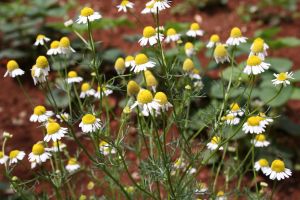Chamomile has been a useful herb for many centuries, and the inspiration for a plethora of literature on the flowering herb. It grows wild in many areas, including England, Germany, Asia, North Africa, and North America. Although there are several  different types of chamomile, the conical centers of the common chamomile flower-heads have become the standard used in herbal medicine.
different types of chamomile, the conical centers of the common chamomile flower-heads have become the standard used in herbal medicine.
Chamomile is widely known for its tonic properties, and one of the most common ingredients in sleep aid teas and herbal sedatives. The flowers have a sweet smell, described by the Greeks as a "ground-apple". The Spaniards call it Manzanilla, which means "little apple". Not all varieties share the same smell, but it is characteristic of the common chamomile plant. It has been said that when placed near other plants that look "less-than-healthy", that it causes most other plants to become healthier within days. The overall health of a garden was determined by the number of chamomile plants growing within the borders.
In the past, it was used for many herbal remedies, many of which are no longer popular as medicinal uses. Considered a very useful herb in women's health, as it is both an emmenagogue and a diuretic, and therefore used during menstration by many women. It was also useful for nervous conditions, and helped in returning a woman from hysterics. It was also considered the only cure and preventative of nightmares, and still used today to induce calming sleep in children and adults. It is relaxing, soothing, and has absolutely no side effects, making it a natural mild sedative that can be taken safely.
For the elderly or those who have a weak appetite, it has been a useful appetite stimulant. Taking one cup of tea about an hour before a meal can greatly improve the ability to eat. When used with ginger root, it can ease indigestion, flatulence, colic, heartburn, occasional headaches, and increase appetite. The anti-diarrheal properties work well to bring normal activity to the bowels, and is a wonderful stomachic. On the flip side, if taken in strong doses it is an effective emetic. When used externally, chamomile was a popular anti-inflammatory, and used as a warm compress to ease the pain and swelling of open wounds, sprains, and bruises.
Tuesday, November 28, 2006
Chamomile is More than Just a Sleepy Tea
Posted by
miss appropriate
at
9:10 AM
![]()
Categories: General Health, Healing Herbs, Herbal Supplements, Home Remedies, Making Herbal Teas, Women's Health
Dedicated to sharing researched information about healing herbs, alternative medicine, natural healthy foods, herbal teas, home remedies, and the importance of avoiding the harmful effects of food additives and artificial ingredients.
